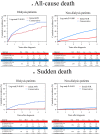Severe Aortic Stenosis in Dialysis Patients
- PMID: 28710181
- PMCID: PMC5586262
- DOI: 10.1161/JAHA.116.004961
Severe Aortic Stenosis in Dialysis Patients
Abstract
Background: Characteristics and prognosis of hemodialysis patients with severe aortic stenosis have not yet been well defined.
Methods and results: The CURRENT AS (contemporary outcomes after surgery and medical treatment in patients with severe aortic stenosis) registry, a Japanese multicenter registry, enrolled 3815 consecutive patients with severe aortic stenosis. There were 405 hemodialysis patients (initial aortic valve replacement [AVR] group: N=135 [33.3%], and conservative group: N=270) and 3410 nonhemodialysis patients (initial AVR group: N=1062 [31.1%], and conservative group: N=2348). The median follow-up duration after the index echocardiography was 1361 days, with 90% follow-up rate at 2 years. The cumulative 5-year incidence of all-cause death was significantly higher in hemodialysis patients than in nonhemodialysis patients in both the entire cohort (71% versus 40%, P<0.001) and in the initial AVR group (63.2% versus 17.9%, P<0.001). Among hemodialysis patients, the initial AVR group as compared with the conservative group was associated with significantly lower cumulative 5-year incidences of all-cause death (60.6% versus 75.5%, P<0.001) and sudden death (10.2% versus 31.7%, P<0.001). Nevertheless, the rate of aortic valve procedure-related death, which predominantly occurred within 6 months of the AVR procedure, was markedly higher in the hemodialysis patients than in the nonhemodialysis patients (21.2% and 2.3%, P<0.001).
Conclusions: Among hemodialysis patients with severe aortic stenosis, the initial AVR strategy as compared with the conservative strategy was associated with significantly lower long-term mortality risk, particularly the risk for sudden death, although the effect size for the survival benefit of the initial AVR strategy was smaller than that in the nonhemodialysis patients.
Keywords: aortic stenosis; hemodialysis; prognosis.
© 2017 The Authors. Published on behalf of the American Heart Association, Inc., by Wiley.
Figures





References
-
- US Renal Data System: USRDS 2014 Annual Data Report. Bethesda, MD: National Institutes of Health, National Institute of Diabetes and Digestive and Kidney Diseases; 2014.
-
- Masakane I, Nakai S, Ogata S, Kimata N, Hanafusa N, Hamano T, Wakai T, Wada A, Nitta K. An overview of regular dialysis treatment in Japan (As of December 31, 2014) [Japanese]. J Jpn Soc Dial Ther. 2016;49:1‐34. - PubMed
-
- Ohara T, Hashimoto Y, Matsumura A, Suzuki M, Isobe M. Accelerated progression and morbidity in patients with aortic stenosis on chronic dialysis. Circ J. 2005;69:1535–1539. - PubMed
-
- Hoshina M, Wada H, Sakakura K, Kubo N, Ikeda N, Sugawara Y, Yasu T, Ako J, Momomura S. Determinants of progression of aortic valve stenosis and outcome of adverse events in hemodialysis patients. J Cardiol. 2012;59:78–83. - PubMed
Publication types
MeSH terms
Substances
LinkOut - more resources
Full Text Sources
Other Literature Sources
Medical
Research Materials

